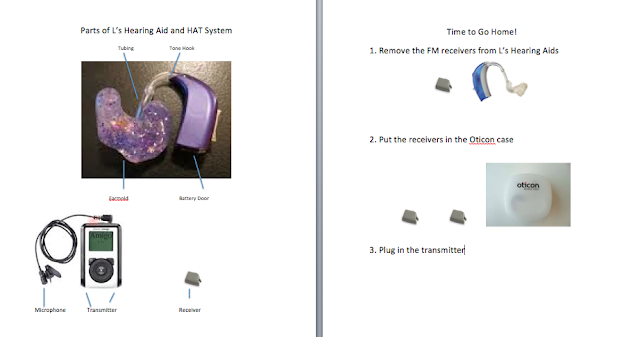Another school year is in full
swing! Recently, as I was preparing for an in-service at one of my schools and
setting up my laptop, I was chatting with the special education teacher about
how far technology has come. During my first few years as an itinerant, I used
to bring stacks of handouts, a CD with hearing loss simulations and a CD player
to play it on. I also had a bulky three-dimensional ear model, as well as model
cochlear implants and hearing aids. So many bags! Now, I just bring my laptop,
which contains all the images, videos, audio samples and information I need!
One thing hasn’t changed though: my role after the in-service.
Although we try to fit the most
important information into that initial meeting, there’s always key follow-up
work to do. During my follow up visit, I demonstrate how to set up each student’s
amplification—whether it's a DAI connection to the classroom soundfield (check
with your educational audiologist to ensure the proper output), or a HAT system
connecting to cochlear implant processors. I provide handouts with each part of
their system labeled, as well as step-by-step instructions (created either by
me or by my students).
I also review with the classroom
teacher or designated school staff member how to do a listening check, and I
provide step–by–step instructions with illustrations for this task as well.
While it’s true that the language I use helps my student to accurately identify
the parts of their technology and understand their importance and the routine,
it also helps teachers who may be unfamiliar with hearing aids and cochlear
implants.
I ask specific questions about
classroom expectations and policies. One of my junior high students was in a
panic because a teacher discussed what it means to be prepared for class, noting
that she would not allow students to go to their lockers for forgotten items.
After meeting with my student and the teacher, he can rest assured that if he
forgets his transmitter or needs a new battery, he can go get it! At times, there do need to be exceptions made
for our students. Similarly, another junior high student who began at a new
school told me that kids are allowed to use their phones during class. Upon
further investigation, we discovered this was not true. Clarifying this policy
prevented her from potentially getting in trouble for doing something that she thought was acceptable.
And I always make sure that everyone
knows my schedule! Each elementary student has my schedule taped to their desk.
This not only helps them remember, but also serves as a reminder to teachers
and substitutes. Older students write my days and times right into their class
schedule, and I email it to all teachers, as well as my primary contact. Finally,
I make sure that the office has my contact information so that if my student is
out, hopefully someone will let me know. J
Here’s to another
great school year!




No comments:
Post a Comment